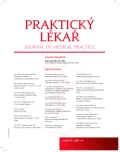Worship of healing deities in ancient Ostia
Authors:
T. Alušík 1,2; P. Hlinovský 2
Authors‘ workplace:
Univerzita Karlova v Praze
1. lékařská fakulta
Ústav dějin lékařství a cizích jazyků
Přednosta: Doc. Mgr. Karel Černý, PhD.
1; České centrum pro středomořskou archeologii, z. s., Praha
Ředitel: Mgr. Jan Kostěnec, PhD.
2
Published in:
Prakt. Lék. 2017; 97(4): 186-190
Category:
Topics/History
Overview
Ostia was the main port of ancient Rome, situated on the left bank of Tiber River. According to the tradition, it was founded by the king Ancus Marcius in the 7th century BC. Already in the Republican era, Ostia became a quite big town with a developed infrastructure, but the main functions and activities in the town were connected to the storing and reloading of goods (especially grain) for Rome. During archaeological excavations a lot of artefacts – both artistic (e.g. relief tombstones) and epigraphic (inscriptions – and several buildings related to the history of ancient medicine were discovered. In this paper, architectural monuments – sanctuaries of ancient healing deities – are presented.
In the north-east part of the sc. Sacred Area of the Republican Temples the remains of the sc. Tetra style Temple are located (Regio I, Insula XV, 2). It is a rectangular temple built on a podium at the end of the 2nd century BC. It was probably dedicated to Aesculapius and his daughter Hygeia, the main healing deities of the Antiquity, who were incorporated into the Roman pantheon from the Greeks in the 3rd century BC. In Ostia, two sanctuaries of Bona Dea were also discovered. Bona Dea (Good Goddess) was a Roman deity of purity, fertility and health, worshipped almost exclusively by women. One of her shrines is located in Regio V, Insula X, 2 and was built already at the beginning of the 2nd century BC. In the first half of the 1st century the second shrine of this goddess was built in Ostia, in Regio IV, Insula VIII, 3.
In Ostia a lot of complexes of baths were uncovered, which points to the important role of hygiene in the life of its inhabitants. Also, the existence of several doctors and possibly of a medical school is documented by the iconographic sources and inscriptions. All these artefacts and presented architectural remains of the sanctuaries confirm the hypothesis that the health ranked among the important values of the local population, which were decisively looked after..
KEYWORDS:
antiquity – Ostia – sanctuary – Aesculapius – Bona Dea
Sources
1. Bakker JT. Regio I – Insula XV – Tempio tetrastilo (I,XV,2) [on line] [cit. 2017-03-16]. Dostupné z: http://www.ostia-antica.org/regio1/15/15-2.htm
2. Bakker JT. Regio IV – Insula VIII - Santuario della Bona Dea IV,VIII,3 [on line] [cit. 2017-03-16]. Dostupné z: http://www.ostia-antica.org/re gio4/8/8-3.htm
3. Bakker JT. Regio V – Insula X – Santuario della Bona Dea V,X,2 [on line]. [cit. 2017-03-16]. Dostupné z: http://www.ostia-antica.org/regio5/10/10-2.htm
4. Bakker JT. (ed.) Ostia: Harbour city of ancient Rome [on line] [cit. 2017-03-16]. Dostupné z: http://www.ostia-antica.org/
5. Boin D. Ostia in Late Antiquity. Cambridge: Cambridge University Press 2013.
6. Bolder-Boos M. Ostia – Der Hafen Roms. Darmstadt: Verlag Philipp von Zabern 2014.
7. Brouwer HHJ. Bona Dea. The sources and a description of the cult. Leiden, New York, Kobenhaven, London: Bril 1989.
8. Calza G. Il tempio della Bona Dea. Notizie degli scavi di antichita 1942 : 7(III): 152–165.
9. Lambrinoudakis VK. Theurgic Medicine. In: Stampolidis N Chr, Tassoulas Y (eds.) Hygieia. Health, Illness, Treatment from Homer to Galen. Athens: Museum of Cycladic Art – Hellenic Ministry of Culture and Sports; 17–31.
10. Medri M, Falzone S, Lo Blundo M, Calvigioni S. Le fasi construttive del Sanctuario di Bona Dea (V, X, 2). Relazione sulle indagini svolte negli anni 2012-2013. FOLD&R Italy (Fasti On Line Documents & Research) 2017; 375 [cit. 2017-03-16]. Dostupné z: http://www.fastionline.org/docs/FOLDER-it-2017-375.pdf
11. Pensabene P. Ostiensium marmorum decus et decor: studi architettonici, decorativi e archeometrici. Roma: L’Erma di Bretschneider 2007.
12. Zevi F. Culti ‘Claudii’ a Ostia e a Roma: qualche osservazione. Archeologia Classica 1997; 49 : 435–471.
Labels
General practitioner for children and adolescents General practitioner for adultsArticle was published in
General Practitioner

2017 Issue 4
- Hope Awakens with Early Diagnosis of Parkinson's Disease Based on Skin Odor
- Metamizole at a Glance and in Practice – Effective Non-Opioid Analgesic for All Ages
- Memantine in Dementia Therapy – Current Findings and Possible Future Applications
- Metamizole vs. Tramadol in Postoperative Analgesia
- Memantine Eases Daily Life for Patients and Caregivers
-
All articles in this issue
- Possibilities of prevention of nosocomial infections in patients before serious surgical procedures
- Opinions of citizens of the Czech republic on selected aspects of the activities of general practitioners – 2016
- Occupational diseases reported in the Czech Republic in 2016
- Relationship between patients’ falls and selected risk factors
- Differentiations in the quality of life perception in seniors
- Trends and correlates of overweight and obesity in Czech adolescents in relation to socioeconomic status of their families between 2002–2014
- Changes in the occurrence of thyroid disease in the Czech Republic according to VZP registry in 2012–2015
- Worship of healing deities in ancient Ostia
- International Ethical Guidelines for Health-related Research Involving Humans
- General Practitioner
- Journal archive
- Current issue
- About the journal
Most read in this issue
- Relationship between patients’ falls and selected risk factors
- Differentiations in the quality of life perception in seniors
- Possibilities of prevention of nosocomial infections in patients before serious surgical procedures
- Trends and correlates of overweight and obesity in Czech adolescents in relation to socioeconomic status of their families between 2002–2014
